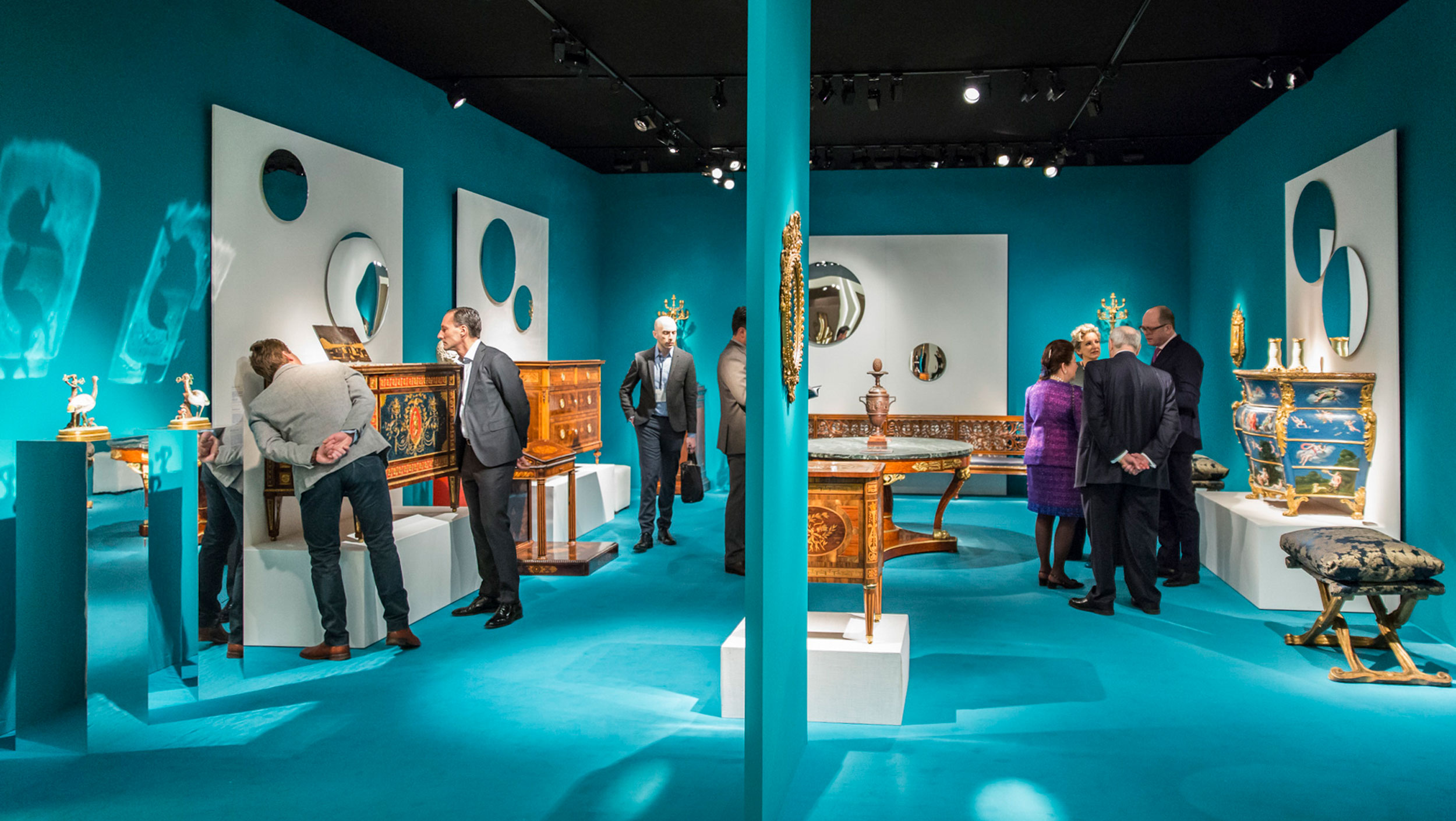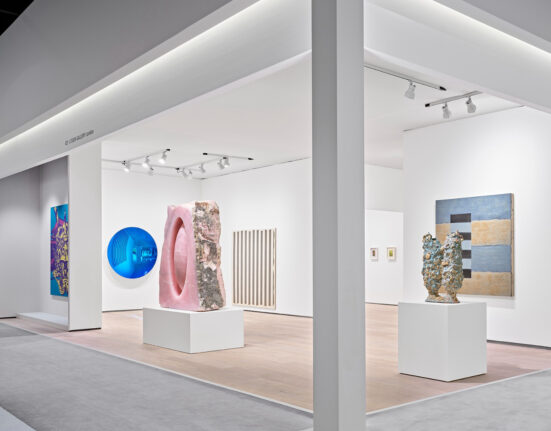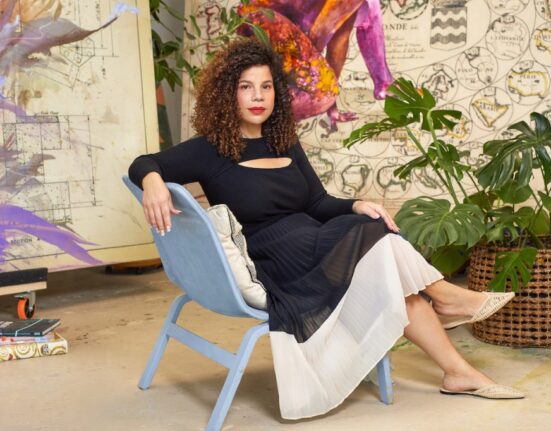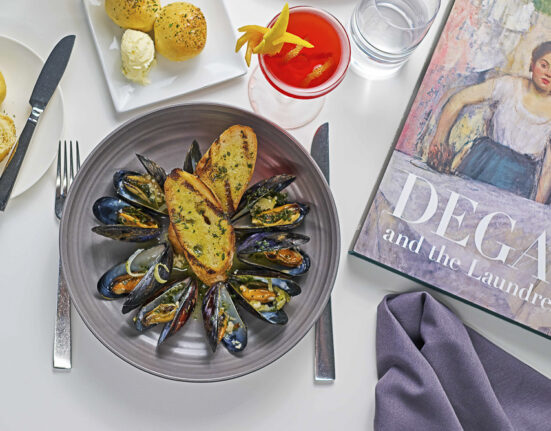Thousands of well-heeled collectors and international museum curators once again descend upon the charming, historic town of Maastricht in South Holland for the European Fine Art Fair (TEFAF), which is held for ten days every March. Hailed as the most prestigious art and antiques fair in the world, this year’s TEFAF (which runs through March 18) has a dizzying 7,000 years of museum-worthy pieces on display by 275 international dealers.
Strolling through the 100,000 square feet of exhibition space is somewhat akin to being in a life-size Wunderkammer, in which ancient artifacts mingle with historic jewels, Old Masters, and modern furniture—and the champagne flows freely. The common thread? Every piece is the best in its field, thanks to the fair’s notoriously strict vetting process. “If you’re here, it’s because you’re at the top of your game,” says Amir Mohtashemi, a London specialist in Indian and Islamic works. “We spend almost the whole year putting together the absolute best pieces to bring.” With a stronger emphasis on design and contemporary art and the desire to reach a more global audience, this year’s trove is truly exceptional.
Here, Galerie’s arts & culture editor shares some of the highlights, from a thrilling Antiques Roadshow–style discovery of an Imperial Russian gold service to a rare lounge by Brazilian design master José Zanine Caldas.
The last surviving Fabergé solid-gold service set, at Wartski
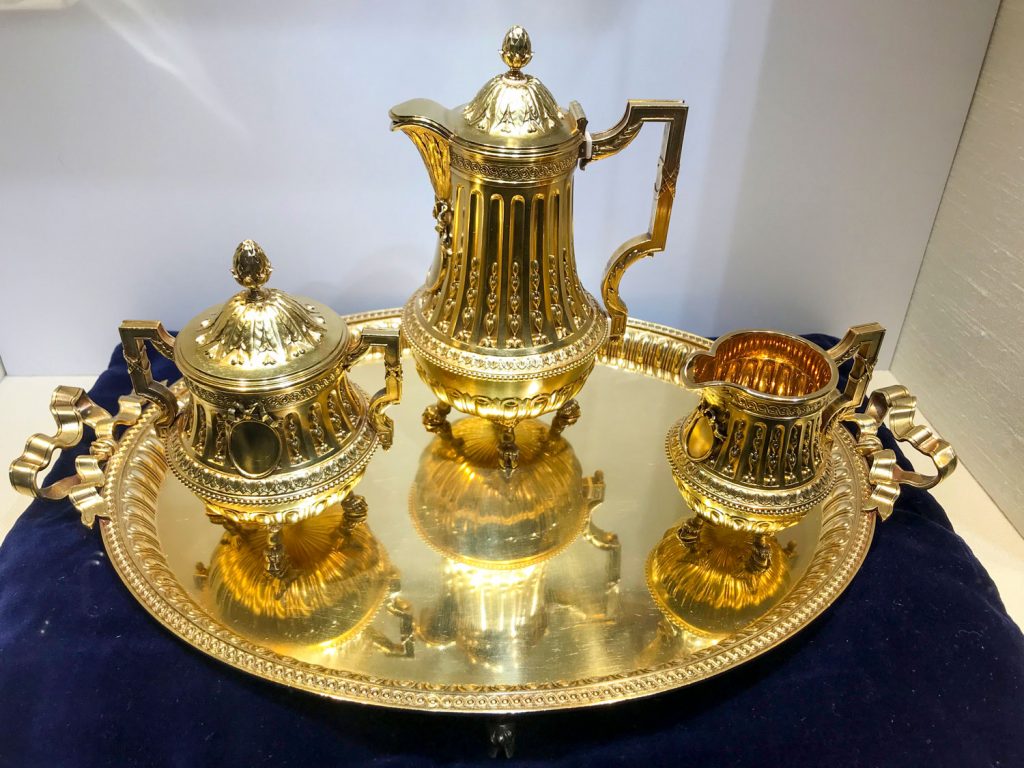
A rare Fabergé gold service, 1890. Photo: Courtesy of Wartski
This coffee set from 1890 is the only surviving gold service by Fabergé left in the world. Made from almost four pounds of solid 18-karat gold, it is a testament to the extraordinary wealth in Imperial Russia—and should have vanished a century ago during the Russian Revolution, when the Bolsheviks melted down the gold and silverware of the elites. “They found these luxury items to be abhorrent manifestations of a society they were trying to change,” explains Kieran McCarthy, an expert on Fabergé and the director of Wartski, the historic London jewelry dealer. “It’s telling of the culture and society. Eating from gold—especially for one!—was the ultimate expression of the power and wealth in society. You can just imagine what the rest of their life was like—it was almost obscene.”
In an Antiques Roadshow turn of events, a “slightly disheveled-looking” man walked into an antiques shop in London in the 1980s and sold the set to a collector before Wartski purchased it for TEFAF, where it is on offer for a seven-figure sum. “If you’re not alerted to how important something in your family is, it can take just one lapse of memory or lapse of communication, and its history and value are lost. Thankfully this incredibly rare piece has been brought back into the world.”
A complex Yup’ik mask, at Donald Ellis Gallery
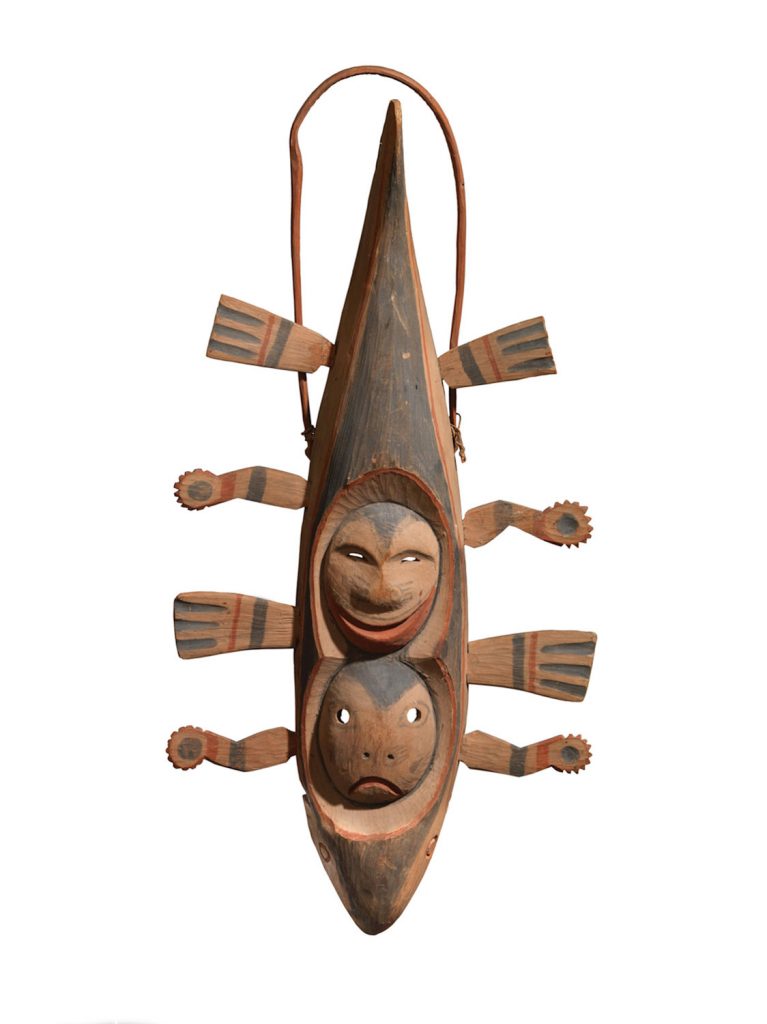
Complex Mask, Yup’ik, Likely Goodnews Bay, Southwest Alaska, c. 1890-1905, wood, paint, vegetal fiber, 34.5 inches. Photo: Courtesy of Donald Ellis Gallery
In the growing tribal section of the fair, veteran New York dealer Donald Ellis, a specialist in Native American art who sells pieces to institutions such as New York’s Metropolitan Museum of Art and Paris’s Musée de Quay Branly, has an elaborate Yup’ik mask from Alaska formerly owned by Surrealist artist Roberto Matta. These masks, which were used in special dances to bring good weather, typically command some of the highest prices in the tribal field. (In 2012, for example, Ellis sold an important Yup’ik mask for $3.8 million.) This particular example sheds light on the enormous influence that the objects had on the Surrealists. New Yorkers can further explore these fascinating connections at Di Donna Gallery in New York, which together with Ellis will present a joint exhibition of the largest group of these masks in private hands from April 27 through June 29.
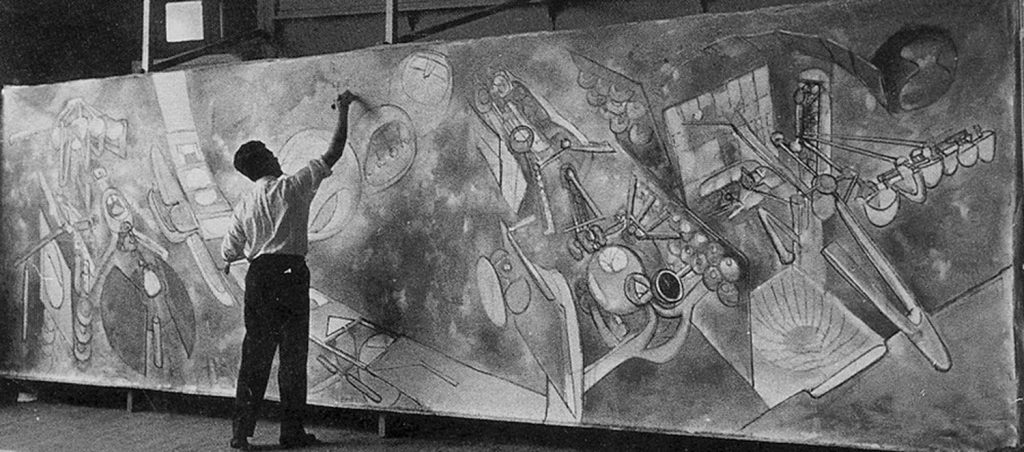
Surrealist artist Roberto Matta in his studio painting the 7-meter mural Vivir enfrentando las flechas for the University of Santiago, 1961. Photo: Courtesy of Matta Art
A rare German Baroque clock from the Bulgari collection, at Galerie J. Kugel

The Bulgari Clock, an ivory and silver-gilt astronomical clock made between 1637-1639. Photo: Courtesy of Galerie J. Kugel
This exquisite astronomical clock caused a buzz at Galerie J. Kugel, one of Paris’s leading antiques dealers. Hailed as a Gesamtkunstwerk, or “total work of art,” the three-tiered wedding-cake-like object reveals the utmost mastery in clockmaking, ivory carving, and goldsmithing. Pointing to the anatomical detail of the ivory figures, particularly a gaunt woman in the grips of death at the top, Laura Kugel explains that each part could exist as an artwork on its own: “It’s a complete masterpiece, and is in full working order.” Boasting a remarkable provenance, it was thought to have belonged to Queen Christina of Sweden, and then the Rothschild family, before it was bought in the early 1960s by Constantino Bulgari of the famed jewelry house. It sold on the first day to a private collector in Europe for an undisclosed sum.
A Fabergé gum pot owned by the Dowager Empress Maria Feodorovna, at A La Vieille Russie
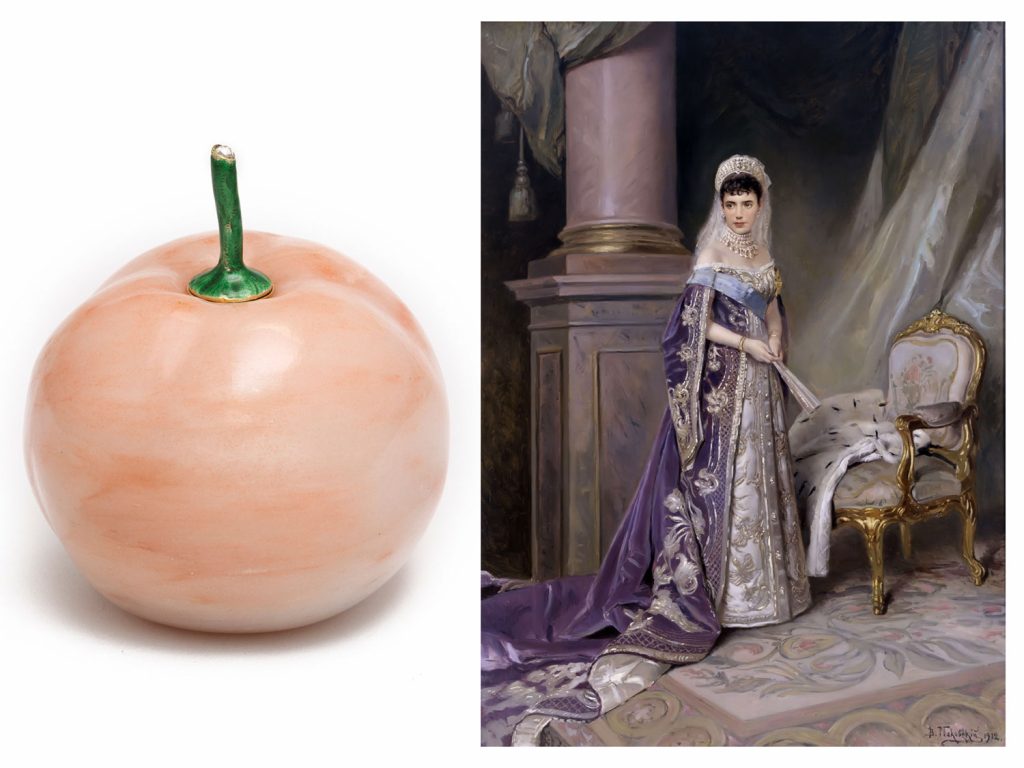
Left: Fabergé gum pot, St. Petersburg, 1899-1901. Right: A portrait of the original owner, the Dowager Empress Maria Feodorovna, by Vladimir Makovskiy, 1912. Photo: Left: Courtesy of A La Vieille Russie. Right: Courtesy of WikiCommons.
For those passionate about the art of letter writing, this delightful object carved in the shape of an apple was once used by the Dowager Empress Maria Feodorovna to seal her envelopes. Crafted by Fabergé workmaster E. Kollin, the decorative gum pot (or glue pot) is made from gold-mounted pale-pink aventurine quartz. The fine enameled stem, which features a rare rose-cut diamond, lifts out to reveal a hidden brush. “It was a time when Fabergé was transforming everyday objects into imaginative works of art,” specialist Adam Patrick tells Galerie. The pot was purchased in 1901 in St. Petersburg for 70 rubles and was on offer for $145,000. Another treasure spotted was an intricate moss agate elephant bell push from around the same period which would have been used by aristocratic families to call the servants quarters with the advent of electricity.
A book by Sonia Delaunay, at Thomas Heneage Art Books
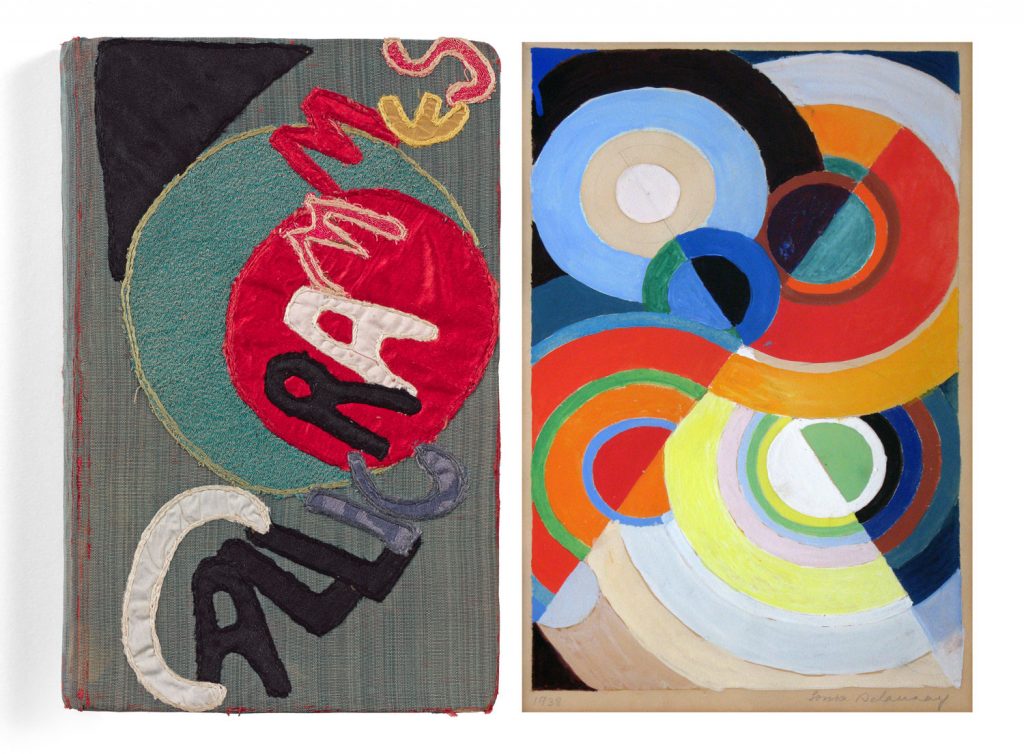
Left: A hand-bound book by Sonia Delaunay for Guillaume Apollinaire’s Calligrammes. Paris, Mercure de France, 1918. Right: A gouache by the artist created in 1938 reveals her colorful, vibrant style. Photo: Courtesy of Thomas Heneage. Right: Courtesy of Fundación Coleccion Thyssen Bornemisza.
This beautiful hand-bound, embroidered book was made in 1918 by the Ukrainian-born French artist Sonia Delaunay, who with her husband Robert and others founded the Orphism movement. It was inspired by her friend—the poet Guillaume Apollinaire—and is only one of three remaining in private hands. She once said: “I bound the books I loved,” and this was created for her personal library, revealing its importance. “This is a unique example of Sonia Delaunay’s work. Her bindings are extremely rare and most are held in public collections,” Thomas Heneage tells Galerie. It was formerly owned by Daniel Filipacchi, chairman emeritus of magazine publisher Hachette Filipacchi Médias and a renowned French collector of Surrealist art. It has a price tag of $280,000.
Lounge by José Zanine Caldas, at Galerie Le Beau
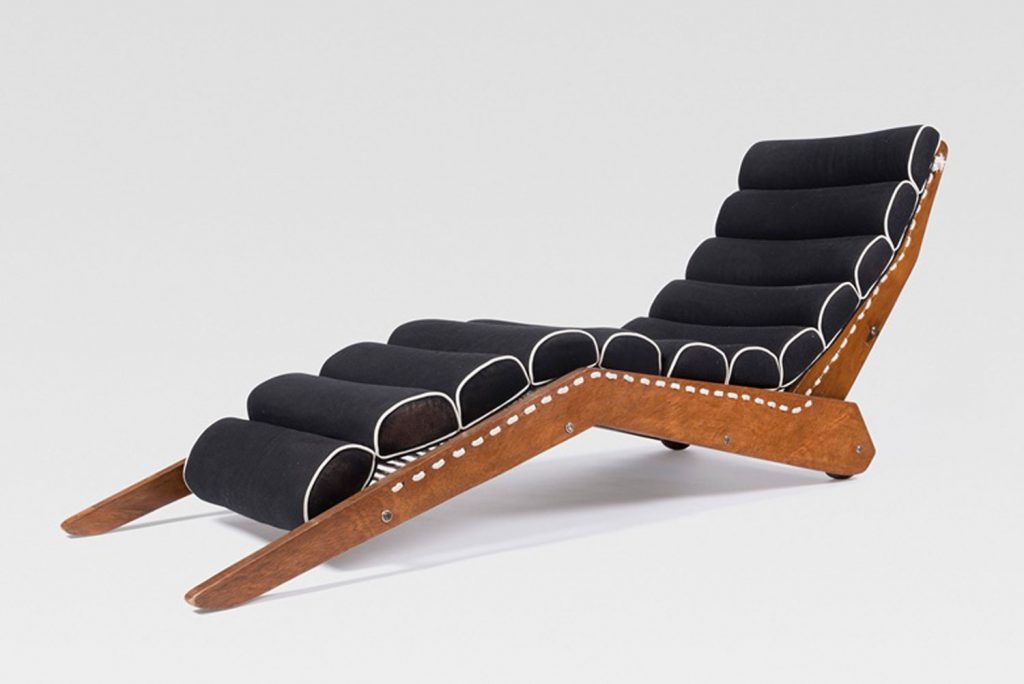
Jose Zanine Caldas, Lounge chair, 1949, manufactured by Moveis Artisticos Z, Mavunia plywood, rope and fabric (reupholstered), 24 x 63 inches. Photo: Courtesy of Galerie Le Beau
This elegant lounge chair, created in 1949 by Brazilian designer and architect José Zanine Caldas, was a showstopper at this Brussels gallery, which focuses on 20th-century works. Cofounder Stanislas Gokelaere tells Galerie: “It was created in his early career when Caldas started the company Móveis Artisticos Z. His objective was to create organically shaped pieces in plywood at a price point that made them accessible to the emerging market of design collectors. His vanguard approach changed design history. However, Caldas would later abandon the project to return to his home state of Bahia, and focus on environmental protection and organic-brutalist furniture.” This model, on offer for 50,000 euros, is extremely rare and possibly a prototype.
The Scream lithograph by Edvard Munch, at David Tunick Inc.

Left: Edvard Munch, The Scream, lithograph on heavy cream wove paper, 1895. Right: One of the five versions of the The Scream, this record-breaking pastel on board was created in the same year.
This super-rare print of The Scream was created by the artist in 1895, the same year as his famous pastel of The Scream, one of the most recognizable artworks in the world (not long ago, it held the record for most expensive work ever sold at auction). When this lithograph was sold at Sotheby’s in 2014 for $2,405,000, it was thought to be a “second-state print,”—a second version— which is less valuable than the first. Since then David Tunick, a specialist in Old Master prints and works on paper, has identified it as a first. He describes the image as “the best known in the history of art, today better known than the Mona Lisa”. Out of the few first-state prints made, the other examples are found in museums such as the Museum of Modern Art in New York. The luminous, solid black inking reveals the artist’s incredible talent for printmaking, as important to Munch as painting, and proves that masterpieces come in many forms. On the first day, it was on reserve for an American collector.
A 1950 gold, diamond, and ruby ring by Salvador Dalí, at Didier Ltd.

Left: Salvatore Dalí’s Portrait of a Passionate Woman, 1950, and right: A painting of the same name created in 1945. Photo: Left: Courtesy of Didier Ltd. Right: Courtesy of WikiCommons.
This unique 18K-gold ring was created by the artist for Mildred “Tweet” Kimball of Colorado. Appropriately titled “Portrait of a Passionate Woman,” the dramatic piece features a platinum dome with pavé-set diamonds, clutched by a pair of spindly gold hands with cabochon ruby fingernails. It was inspired by a painting he made in 1945 of the same title. Kimball was a larger-than-life heiress who amassed one of the country’s most eclectic art and book collections. After separating from her first husband, he bought her a Scottish-style castle on a 5,000-acre parcel, called Cherokee Ranch, where she lived until her death. “He said would buy her anything as long as it was west of the Mississippi as he was only going to live East of it. She then went on to have another three husbands. It’s a wonderful story. She was as eccentric as they come,” says Didier director Martine Haspeslagh. The Cherokee Ranch and Castle Foundation Estate, regrettably, sold the ring 15 years ago. It’s now on sale at Didier for $280,000.
A still life by Ambrosius Bosschaert the Elder of a ribbed globular vase holding a bouquet, at David Koetser

A still life by Ambrosius Bosschaert the Elder of a ribbed globular vase holding a bouquet, 1605-1610. Photo: Courtesy of David Koetser
A perfectly fitting masterpiece for the Dutch fair, this small still life by Ambrosius Bosschaert the Elder is arguably one of the most beautiful 17th-century flower paintings on offer. Bosschaert was a pioneer in Dutch flower painting and could be credited for making the genre popular. Here, the ribbed-glass vase depicts an imagined bouquet of exotic flowers, including white and red roses, various striped tulips, anemones, double narcissi, and pansies. “In 1632, someone reportedly paid 30,000 guilder for a single tulip bulb,” the gallery director says. “Flowers were extremely exotic and something to be coveted, which led to the commissioning of paintings. The insects would not only make them look more lifelike but acted as a message that beauty is fleeting, something that Dalí would pick up later.” In a private Swiss collection for several generations, the special piece is available for 4.6 million euros. “People who buy these types of paintings loan them to museums. They need to be seen.”
17th-century royal wallpaper panels, at Carolle Thibaut-Pomerantz
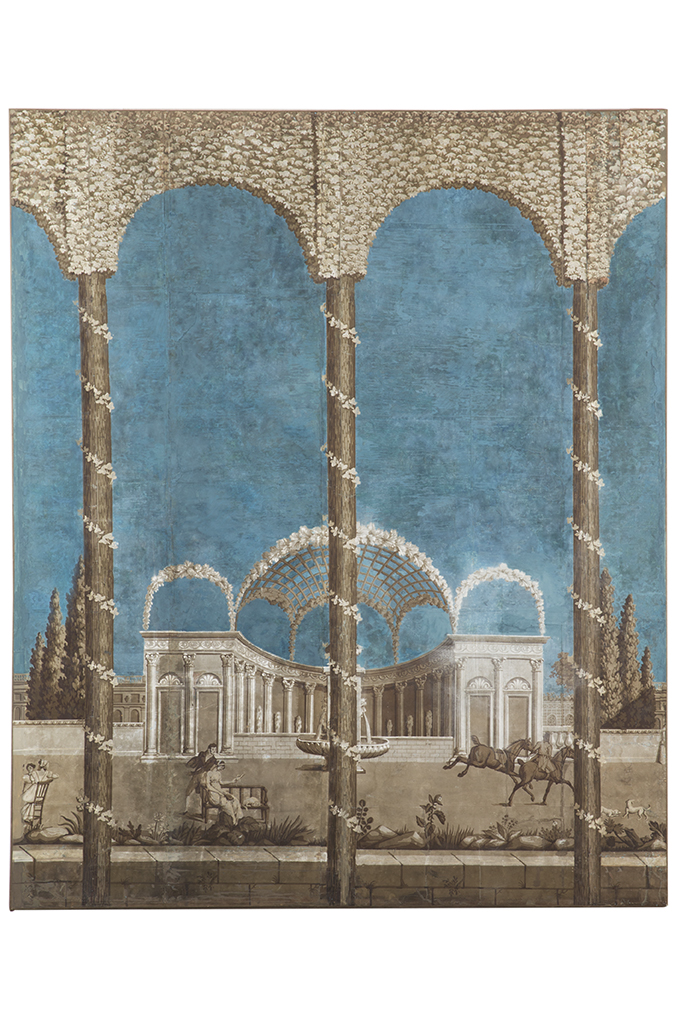
A panel of wallpaper titled “Palais Royal”. Photo: Courtesy of the gallery
Interior designers and decorative arts connoisseurs know to visit Thibaut-Pomerantz, an art historian and dealer of vintage wallpaper panels—particularly French period papers—and one of a handful of female dealers at the fair. Showcasing a lost art form, she displays a series of circa-1805 French panoramic wallpaper panels titled “Palais Royal.” Not only are the richly colored blue panels exquisitely handprinted using hundreds of carved-wood blocks, but they reveal the shifting relationship between high art and popular culture during the 18th century as wallpaper began to transform homes.
A pair of Pegasus earrings, at Hemmerle

Hemmerle Pegasus Earrings with diamonds, aluminum, and white gold. Photo: Courtesy of Hemmerle
A pair of earrings, made of blue anodized aluminum and white gold with diamonds depicting two Pegasus horses, are a highlight at the avant-garde Munich jeweler Hemmerle. It forms part of a gorgeous ten-piece collection that draws on the brand’s heritage as a ceremonial medalmaker to the Royal Bavarian court, and the recent discovery of a box of embossing stamps that had been buried in the cellars of the atelier since 1904. The one-of-a-kind pieces can take around 500 hours to create with a team of master artisans, and employ the brand’s signature unexpected material combinations (think copper, wood, or pebbles with super-rare, often indefinable gems).
Alberto Giacometti, Atelier I, 1950, at Thomas Gibson Fine Art
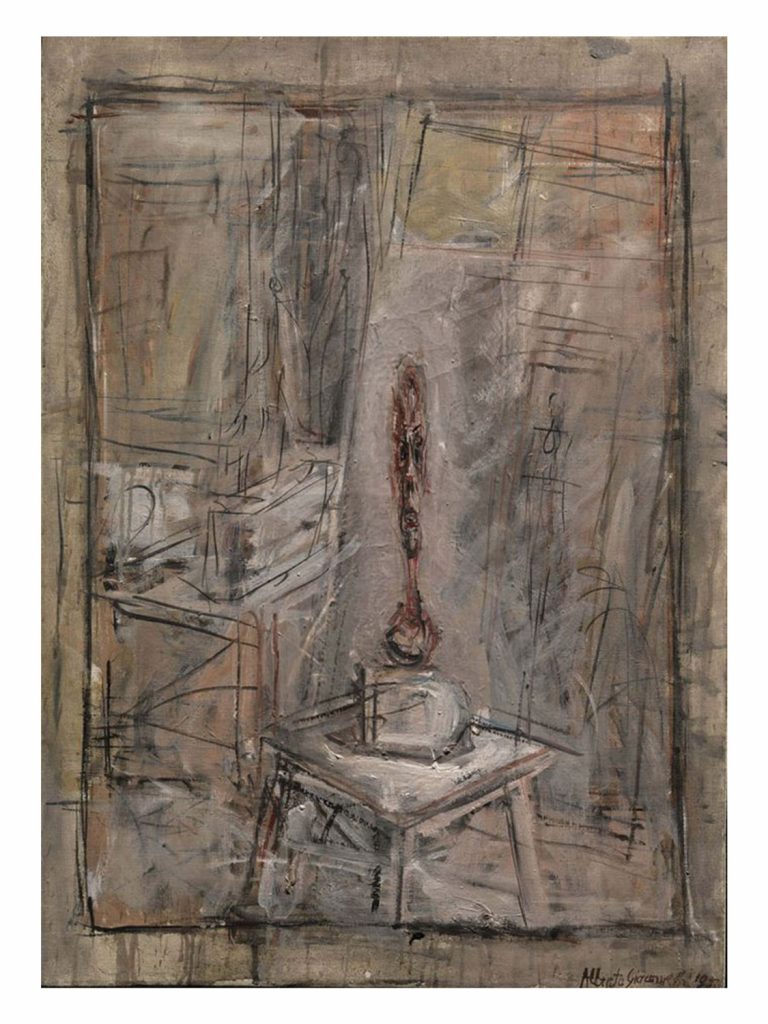
Alberto Giacometti, Atelier, 1950. Photo: Courtesy of Thomas Gibson
This painting depicts the artist’s infamous, chaotic studio, shedding light on his frenetic creative process. The walls are covered in graffiti, and the room is filled with smoke, plaster debris, and a jumble of sculptures and objects. London dealer Thomas Gibson, who has been showing Giacometti’s art since the 1970s, has three works by the artist at his booth. This one is on offer for $5.8 million. It’s certainly the year for Giacometti: This summer, the Solomon R. Guggenheim Museum in New York is hosting the largest retrospective of Giacometti’s work, and the Giacometti Foundation in Paris is opening an institute that includes a complete re-creation of his studio.
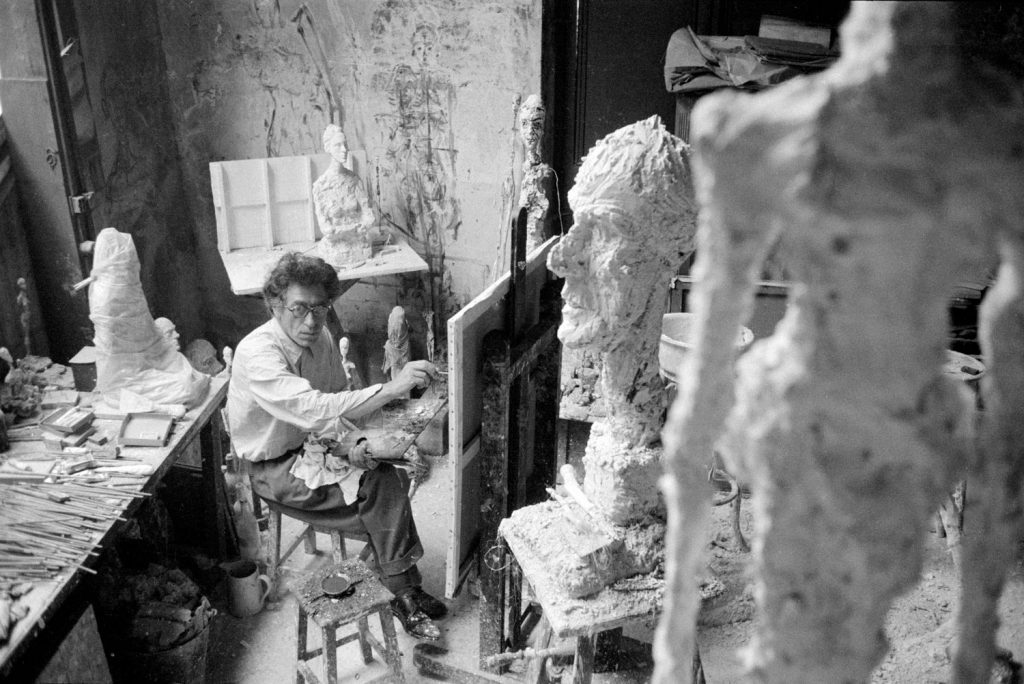
Alberto Giacometti working in his studio. Photo: Ernst Scheidegger;
courtesy of the Tate
The European Fine Art Fair runs through March 18, at MECC, Maastricht.
Cover: Visitors admiring the pieces on offer at Luca Burzio during the VIP preview.
Photo: Courtesy of TEFAF

